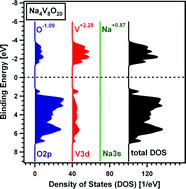In this work the electronic structure of V2O5, reduced V2O5−x (V16O39) and sodium intercalated NaV2O5 has been studied by both theoretical and experimental methods. Theoretical band structure calculations have been performed using density functional methods (DFT). We have investigated the electron density distribution of the valence states, the total density of states (total DOS) and the partial valence band density of states (PVBDOS). Experimentally, amorphous V2O5 thin films have been prepared by physical vapour deposition (PVD) on freshly cleaved highly oriented pyrolytic graphite (HOPG) substrates at room temperature with an initial oxygen understoichiometry of about 4%, resulting in a net stoichiometry of V2O4.8. These films have been intercalated by sodium using vacuum deposition with subsequent spontaneous intercalation (NaV2O5) at room temperature. Resonant V3p–V3d photoelectron spectroscopy (ResPES) experiments have been performed to determine the PVBDOS focusing on the calculation of occupation numbers and the determination of effective oxidation state, reflecting ionicity and covalency of the V–O bonds. Using X-ray absorption near edge spectra (XANES) an attempt is made to visualize the changes in the unoccupied DOS due to sodium intercalation. For comparison measurements on nearly stoichiometric V2O5 single crystals have been performed. The experimental data for the freshly cleaved and only marginally reduced V2O5 single crystals and the NaV2O5 results are in good agreement with the calculated values. The ResPES results for V2O4.8 agree in principle with the calculations, but the trends in the change of the ionicity differ between experiment and theory. Experimentally we find partly occupied V 3d states above the oxygen 2p-like states and a band gap between these and the unoccupied states. In theory one finds this occupation scheme assuming oxygen vacancies in V2O5 and by performing a spin-polarized calculation of an antiferromagnetic ordered NaV2O5.

You have access to this article
 Please wait while we load your content...
Something went wrong. Try again?
Please wait while we load your content...
Something went wrong. Try again?


 Please wait while we load your content...
Please wait while we load your content...